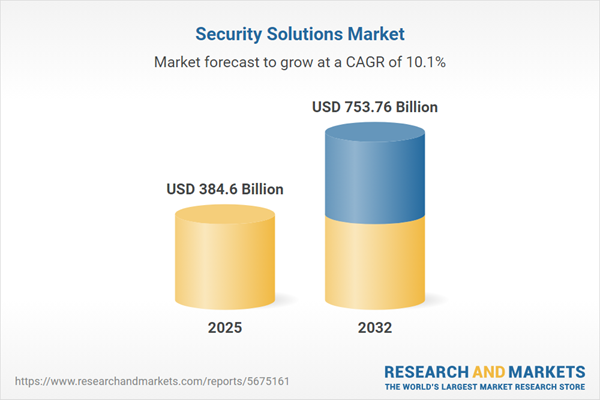Speak directly to the analyst to clarify any post sales queries you may have.
The security solutions market is rapidly adapting as organizations face fast-changing risks across digital and physical operations. Senior leaders are increasingly integrating security with business objectives to maintain continuity, uphold compliance, and protect mission-critical assets.
Market Snapshot: Security Solutions Market Size and Growth
The global security solutions market is projected to grow from USD 349.62 billion in 2024 to USD 384.60 billion in 2025, and is expected to reach USD 753.76 billion by 2032, reflecting a compound annual growth rate (CAGR) of 10.07%. This robust expansion is driven by rising digitalization, increasingly complex cyber-physical threats, and evolving regulatory demands. As organizations reassess risk management strategies, integrated security platforms play a crucial role in achieving business continuity and maintaining competitive advantage. Flexible and scalable security architectures enable organizations to operate with confidence in regulated environments, quickly addressing both established and novel threats.
Scope & Segmentation of the Security Solutions Market
This report provides segmentation to support informed security strategy development in line with today’s dynamic threats and compliance requirements:
- Security Types: Cybersecurity and physical security solutions cover networks, endpoints, identity and access management, analytics, intrusion detection, fire safety, and surveillance to build comprehensive risk reduction across business operations.
- Components: Consulting, managed and professional services, software, platforms, maintenance, and advanced hardware drive modernization and enable organizations to respond to changing threat environments.
- Deployment Modes: Cloud, hybrid, and on-premises security allow organizations to align technology with operational needs, digital transformation pace, and compliance obligations.
- End-User Industries: Sectors including banking, government, healthcare, manufacturing, retail, IT and telecom, transportation, logistics, energy, and utilities adopt tailored security strategies to mitigate sector-specific challenges and regulatory pressures.
- Organization Sizes: Solutions support scalability for both large enterprises and SMEs, addressing diverse resource levels and in-house expertise.
- Regions Covered: Analysis spans the Americas, Europe, Middle East & Africa, and Asia-Pacific, tracking region-specific security trends, adoption patterns, and compliance landscapes.
- Key Companies Profiled: In-depth profiles of leading providers, including Microsoft Corporation, Cisco Systems, Broadcom, Palo Alto Networks, Fortinet, Check Point Software Technologies, CrowdStrike Holdings, Trend Micro, IBM, and VMware, offer insights critical for vendor selection and procurement planning.
Key Takeaways for Senior Decision-Makers
- Integrating digital and physical security streamlines risk management, supporting resilience and smoother business operations in increasingly interconnected environments.
- Cloud-native and software-centric architectures provide agility, enabling organizations to quickly adapt to evolving regulations and accelerate secure digital initiatives.
- Artificial intelligence and machine learning technologies facilitate faster threat detection and response, helping organizations stay proactive in distributed and complex security contexts.
- Industry- and region-specific solutions address distinct compliance requirements and operational exposures, equipping organizations with flexibility and precision in their security approaches.
- Managed security services close resource and skills gaps, providing ongoing incident response and elevating overall security frameworks, especially where in-house expertise may be limited.
- Collaboration with established vendors ensures deployment of interoperable security solutions and supports effective supplier management during operational changes or scaling initiatives.
Tariff Impact: U.S. Policy Drivers and Global Supply Chain Adaptation
Recent U.S. tariff changes require organizations to reassess manufacturing and supply chain strategies. Adopting software-driven and as-a-service security models allows businesses to adapt more quickly, reduce reliance on hardware, and maintain stability in the face of ongoing supply chain disruptions. These approaches help organizations sustain compliance and operational reliability during periods of regulatory transition.
Methodology & Data Sources
This report leverages comprehensive secondary research, detailed analysis of recognized industry standards, and direct validation by security solution suppliers. Insights are further strengthened by interviews and executive roundtables with security professionals to ensure actionable and relevant findings.
Why This Report Matters
- Empowers executives to align security investments with evolving risk environments and governance standards, enhancing strategic decision-making across diverse sectors.
- Delivers clear benchmarks and transparent vendor criteria to improve collaboration, procurement outcomes, and long-term security objectives globally.
- Equips leadership with actionable, region-specific strategies for managing risk and ensuring compliance in complex market dynamics.
Conclusion
This report offers senior leaders practical insights for optimizing security architectures, guiding strategic investments, and supporting operational resilience in demanding, rapidly shifting markets.
Additional Product Information:
- Purchase of this report includes 1 year online access with quarterly updates.
- This report can be updated on request. Please contact our Customer Experience team using the Ask a Question widget on our website.
Table of Contents
3. Executive Summary
4. Market Overview
7. Cumulative Impact of Artificial Intelligence 2025
Companies Mentioned
The companies profiled in this Security Solutions market report include:- Microsoft Corporation
- Cisco Systems, Inc.
- Broadcom Inc.
- Palo Alto Networks, Inc.
- Fortinet, Inc.
- Check Point Software Technologies Ltd.
- CrowdStrike Holdings, Inc.
- Trend Micro Incorporated
- International Business Machines Corporation
- VMware, Inc.
Table Information
| Report Attribute | Details |
|---|---|
| No. of Pages | 186 |
| Published | October 2025 |
| Forecast Period | 2025 - 2032 |
| Estimated Market Value ( USD | $ 384.6 Billion |
| Forecasted Market Value ( USD | $ 753.76 Billion |
| Compound Annual Growth Rate | 10.0% |
| Regions Covered | Global |
| No. of Companies Mentioned | 11 |









